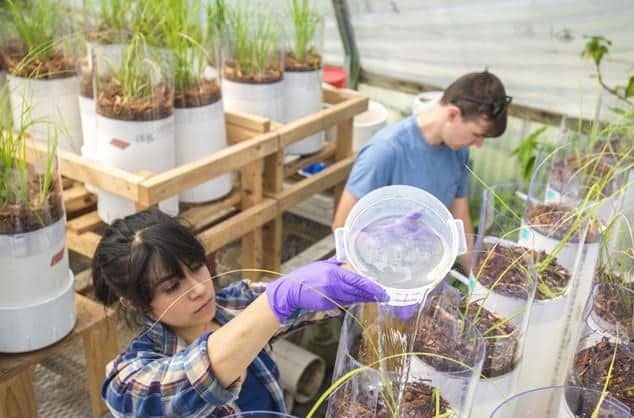
California State University, Chico is working to transform the undergraduate experience and enhance student success with a new program to cultivate entrepreneurial mindsets and research opportunities right within the everyday classroom.
This month, the National Science Foundation (NSF) awarded CSU, Chico a $2.2 million grant for “STEM Course Transformation,” a collaborative vision by the Chico STEM Connections Collaborative (CSC2) team, faculty from the College of Engineering, Computer Science and Construction Management (ECC), and Chico State Enterprises.
The funds will support a program that trains faculty in science, technology, engineering and mathematics (STEM) courses to launch the Course-Based Undergraduate Research Experience (CURE) model into University classrooms over the next five years. Faculty training will begin this summer, with deployment into three classrooms in fall 2020.
“We really hope this is a game-changer for us to increase retention for first- and second-year students,” said co-principal investigator Lorena Navarro. “Besides just going to class and listening to lectures, if students can get interested in research and entrepreneurship, we hope they will want to stay in their major. We want them to think about research but also what can they do with it.”
After starting with classes in biology, computer science and math, the CURE program will continue to add trained faculty and three classes each year, focusing on lower-division classes with high enrollment and significant rates of students who drop, fail or withdraw from the courses. Ultimately, they hope to target more than 8,100 students with help from 63 faculty.
“Part of the process for us was identifying what the needs are on campus, what students need, and what is specific to Chico State,” said JoAna Brooks, the project’s director and mentor coordinator for CSC2. “We were really diligent in looking at what students were doing in their STEM courses and if there was a point where they choose to leave their STEM major. … With this project, we are able to make sure we are supporting, encouraging and offering something to get them to move to the next level. This just opens up the doors to so many more students to have that opportunity.”
Navarro knows the experience firsthand. As an undergraduate who was raised in a small town, she said the chance to do research as an undergraduate was “a gamechanger” that inspired her to pursue a PhD. As the community college liaison and coordinator for CSC2 for the College of Natural Sciences, she’s seen a similar outcome in CSU, Chico students. One student, she said, did research on a project related to salmon one summer instead of working retail, which led to an off-campus research opportunity at University of California, Santa Barbara, and seven interviews for research programs at top schools. He recently accepted an offer at UC San Francisco, one of the most prestigious PhD programs in the nation.
While the CURE model is growing in popularity in higher education, Navarro said, CSU, Chico distinguished itself by adding an entrepreneurial component. While such endeavors may be common in engineering, the program team hopes to create a spotlight for students in the natural sciences and agriculture disciplines that they also have room for creative business ventures and solutions.
The University was able to secure this prominent grant due to its designation as a Hispanic-Serving Institution (HSI). As the NSF seeks to improve undergraduate education, it is awarding these funds to enhance the quality of undergraduate STEM education at HSIs and increase the retention and graduation rates of students pursuing associate or baccalaureate degrees in STEM.
The CURE program will build off the existing success of CSC2, which was established by a five-year, $4.3 million grant from the U.S. Department of Education in 2016 to support low-income students and students pursuing studies in the Colleges of Agriculture, Natural Sciences, and ECC. In the last four years, more than 600 students have annually participated in CSC2, gaining academic support, peer mentoring, financial literacy, undergraduate research opportunities and community college transfer student support.
“When we got that grant, one of the things we looked at and discussed as a team was to parlay that success into other opportunities,” said Paul Villegas, director of CSC2. “This is the first of a couple of attempts the team members have worked on and have been successful at it. Their hard work has paid off.”
One of the University’s goals is to create an undergraduate research center that represents multiple disciplines. This grant and resulting project will go a long way toward making that a reality, Villegas said.
The grant is led by Principal Investigator David Alexander, vice chair of the Department of Mechanical and Mechatronic Engineering and Sustainable Manufacturing, and Co-Principal Investigators Navarro; Brooks; Debra Larson, provost and vice president for Academic Affairs; and Kate McCarthy, dean of Undergraduate Education.
by Ashley Gebb
Please visit https://today.csuchico.edu/nsf-grant-for-undergraduate-research/ to view the original article.
Founded in 1978, the Council on Undergraduate Research (CUR) focuses on providing high-quality and collaborative undergraduate research, scholarly, and creative activity. Among the many activities and networking opportunities that CUR provides, the organization also offers support for the professional growth of faculty and administrators through expert-designed institutes, conferences, and a wide-range of volunteer positions. The CUR community, made up of nearly 700 institutions and 13,000 individuals, continues to provide a platform for discussion and other resources related to mentoring, connecting, and creating relationships centered around undergraduate research. CUR’s advocacy efforts are also a large portion of its work as they strive to strengthen support for undergraduate research. Its continued growth in connections with representatives, private foundations, government agencies, and campuses world-wide provides value to its members and gives voice to undergraduate research. CUR is committed to inclusivity and diversity in all of its activities and our community.
CUR focuses on giving a voice to undergraduate research with learning through doing. It provides connections to a multitude of campuses and government agencies, all while promoting networking and professional growth to its community.


